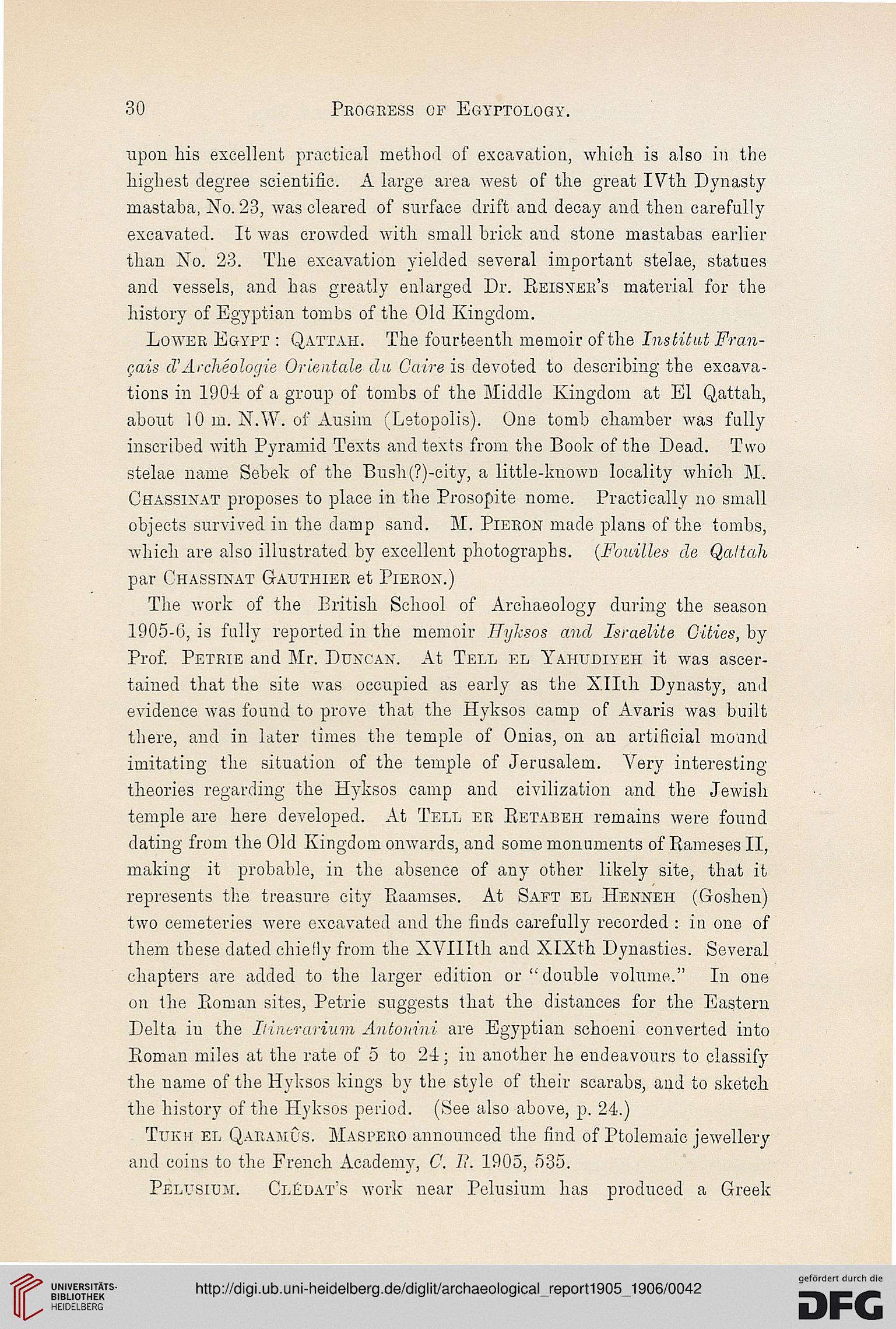30
Peogeess of Egyptology.
upon his excellent practical method of excavation, which is also in the
highest degree scientific. A large area west of the great IVth Dynasty
niastaba, No. 23, was cleared of surface drift and decay and then carefully
excavated. It was crowded with small brick and stone mastabas earlier
than No. 23. The excavation yielded several important stelae, statues
and vessels, and has greatly enlarged Dr. Eeis^ek's material for the
history of Egyptian tombs of the Old Kingdom.
Lower Egypt : Qattah. The fourteenth memoir of the Ins tit ut Fran-
cais d'Archeologie Orientate da Caire is devoted to describing the excava-
tions in 1904 of a group of tombs of the Middle Kingdom at El Qattah,
about 10 m. N.W. of Ausim (Lstopolis). One tomb chamber was fully
inscribed with Pyramid Texts and texts from the Book of the Dead. Two
stelae name Sebek of the Bush(?)-city, a little-knowD locality which M.
Chassinat proposes to place in the Prosopite nome. Practically no small
objects survived in the damp sand. M. Pleron made plans of the tombs,
which are also illustrated by excellent photographs. (Fouilles de Qattah
par Chassinat Gauthier et Pieron.)
The work of the British School of Archaeology during the season
1905-6, is fully reported in the memoir Hyksos and Israelite Cities, by
Prof. Petrie and Mr. Duncan. At Tell el Yahudiyeh it was ascer-
tained that the site was occupied as early as the Xllth Dynasty, and
evidence was found to prove that the Hyksos camp of Avaris was built
there, and in later times the temple of Onias, on an artificial mound
imitating the situation of the temple of Jerusalem. Very interesting
theories regarding the Hyksos camp and civilization and the Jewish
temple are here developed. At Tell er Ketabeii remains were found
dating from the Old Kingdom onwards, and some monuments of Rameses II,
making it probable, in the absence of any other likely site, that it
represents the treasure city Baamses. At Saft el Henneh (Goshen)
two cemeteries were excavated and the finds carefully recorded : in one of
them these dated chiefly from the XVIIIth and XlXth Dynasties. Several
chapters are added to the larger edition or "double volume." In one
on the Roman sites, Petrie suggests that the distances for the Eastern
Delta in the Ilinerarium Antonini are Egyptian schoeni converted into
Roman miles at the rate of 5 to 24; in another he endeavours to classify
the name of the Hyksos kings by the style of their scarabs, and to sketch
the history of the Hyksos period. (See also above, p. 24.)
Tukh el Qaramus. Maspero announced the find of Ptolemaic jewellery
and coins to the French Academy, C. It. 1905, 535.
PiLUSlTJM. Cl£uat's work near Pelusium has produced a Greek
Peogeess of Egyptology.
upon his excellent practical method of excavation, which is also in the
highest degree scientific. A large area west of the great IVth Dynasty
niastaba, No. 23, was cleared of surface drift and decay and then carefully
excavated. It was crowded with small brick and stone mastabas earlier
than No. 23. The excavation yielded several important stelae, statues
and vessels, and has greatly enlarged Dr. Eeis^ek's material for the
history of Egyptian tombs of the Old Kingdom.
Lower Egypt : Qattah. The fourteenth memoir of the Ins tit ut Fran-
cais d'Archeologie Orientate da Caire is devoted to describing the excava-
tions in 1904 of a group of tombs of the Middle Kingdom at El Qattah,
about 10 m. N.W. of Ausim (Lstopolis). One tomb chamber was fully
inscribed with Pyramid Texts and texts from the Book of the Dead. Two
stelae name Sebek of the Bush(?)-city, a little-knowD locality which M.
Chassinat proposes to place in the Prosopite nome. Practically no small
objects survived in the damp sand. M. Pleron made plans of the tombs,
which are also illustrated by excellent photographs. (Fouilles de Qattah
par Chassinat Gauthier et Pieron.)
The work of the British School of Archaeology during the season
1905-6, is fully reported in the memoir Hyksos and Israelite Cities, by
Prof. Petrie and Mr. Duncan. At Tell el Yahudiyeh it was ascer-
tained that the site was occupied as early as the Xllth Dynasty, and
evidence was found to prove that the Hyksos camp of Avaris was built
there, and in later times the temple of Onias, on an artificial mound
imitating the situation of the temple of Jerusalem. Very interesting
theories regarding the Hyksos camp and civilization and the Jewish
temple are here developed. At Tell er Ketabeii remains were found
dating from the Old Kingdom onwards, and some monuments of Rameses II,
making it probable, in the absence of any other likely site, that it
represents the treasure city Baamses. At Saft el Henneh (Goshen)
two cemeteries were excavated and the finds carefully recorded : in one of
them these dated chiefly from the XVIIIth and XlXth Dynasties. Several
chapters are added to the larger edition or "double volume." In one
on the Roman sites, Petrie suggests that the distances for the Eastern
Delta in the Ilinerarium Antonini are Egyptian schoeni converted into
Roman miles at the rate of 5 to 24; in another he endeavours to classify
the name of the Hyksos kings by the style of their scarabs, and to sketch
the history of the Hyksos period. (See also above, p. 24.)
Tukh el Qaramus. Maspero announced the find of Ptolemaic jewellery
and coins to the French Academy, C. It. 1905, 535.
PiLUSlTJM. Cl£uat's work near Pelusium has produced a Greek




